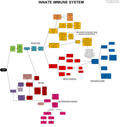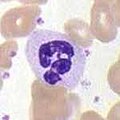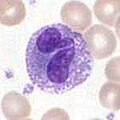Innate immune system
Innate immune system is a part of the overall immune system that comprises the cells and mechanisms that defend the host from infection by other organisms in a non-specific manner. This means that the cells of the innate system recognize and respond to pathogens in a generic way, but unlike the adaptive immune system, it does not confer long-lasting or protective immunity to the host.
Components of the Innate Immune System[edit]
The innate immune system is composed of physical and chemical barriers, phagocytic leukocytes, dendritic cells, natural killer cells, and circulating plasma proteins.
Physical and Chemical Barriers[edit]
The physical barriers of the innate immune system include the skin and mucous membranes. These barriers are very effective in blocking most pathogens from entering the body. The chemical barriers include the acidic environment of the stomach and antimicrobial substances like lysozyme in tears and saliva.
Phagocytic Leukocytes[edit]
Phagocytic leukocytes, which include neutrophils and macrophages, are able to ingest and destroy pathogens. They are attracted to the site of infection by chemical signals, in a process known as chemotaxis.
Dendritic Cells[edit]
Dendritic cells are antigen-presenting cells that process antigen material and present it on the cell surface to the T cells of the immune system. They act as messengers between the innate and the adaptive immune systems.
Natural Killer Cells[edit]
Natural killer cells (NK cells) are a type of cytotoxic lymphocyte that is capable of killing infected cells and tumor cells. They are part of the innate immune system due to their ability to recognize stressed cells in the absence of antibodies and MHC, allowing for a much faster immune reaction.
Circulating Plasma Proteins[edit]
The circulating plasma proteins, also known as the complement system, enhance the ability of antibodies and phagocytic cells to clear microbes and damaged cells from an organism, promote inflammation, and attack the pathogen's cell membrane.
Function of the Innate Immune System[edit]
The innate immune system provides an immediate but non-specific response to pathogens. It also plays a crucial role in the activation of the adaptive immune system. The innate immune response is activated by chemical properties of the antigen.
See Also[edit]

This article is a immunology stub. You can help WikiMD by expanding it!
-
Innate immune system
-
Scanning electron micrograph of blood cells
-
Macrophage engulfing bacteria
-
Peripheral blood neutrophil
-
Peripheral blood eosinophil
Ad. Transform your life with W8MD's Budget GLP-1 injections from $75


W8MD offers a medical weight loss program to lose weight in Philadelphia. Our physician-supervised medical weight loss provides:
- Weight loss injections in NYC (generic and brand names):
- Zepbound / Mounjaro, Wegovy / Ozempic, Saxenda
- Most insurances accepted or discounted self-pay rates. We will obtain insurance prior authorizations if needed.
- Generic GLP1 weight loss injections from $75 for the starting dose.
- Also offer prescription weight loss medications including Phentermine, Qsymia, Diethylpropion, Contrave etc.
NYC weight loss doctor appointmentsNYC weight loss doctor appointments
Start your NYC weight loss journey today at our NYC medical weight loss and Philadelphia medical weight loss clinics.
- Call 718-946-5500 to lose weight in NYC or for medical weight loss in Philadelphia 215-676-2334.
- Tags:NYC medical weight loss, Philadelphia lose weight Zepbound NYC, Budget GLP1 weight loss injections, Wegovy Philadelphia, Wegovy NYC, Philadelphia medical weight loss, Brookly weight loss and Wegovy NYC
|
WikiMD's Wellness Encyclopedia |
| Let Food Be Thy Medicine Medicine Thy Food - Hippocrates |
Medical Disclaimer: WikiMD is not a substitute for professional medical advice. The information on WikiMD is provided as an information resource only, may be incorrect, outdated or misleading, and is not to be used or relied on for any diagnostic or treatment purposes. Please consult your health care provider before making any healthcare decisions or for guidance about a specific medical condition. WikiMD expressly disclaims responsibility, and shall have no liability, for any damages, loss, injury, or liability whatsoever suffered as a result of your reliance on the information contained in this site. By visiting this site you agree to the foregoing terms and conditions, which may from time to time be changed or supplemented by WikiMD. If you do not agree to the foregoing terms and conditions, you should not enter or use this site. See full disclaimer.
Credits:Most images are courtesy of Wikimedia commons, and templates, categories Wikipedia, licensed under CC BY SA or similar.
Translate this page: - East Asian
中文,
日本,
한국어,
South Asian
हिन्दी,
தமிழ்,
తెలుగు,
Urdu,
ಕನ್ನಡ,
Southeast Asian
Indonesian,
Vietnamese,
Thai,
မြန်မာဘာသာ,
বাংলা
European
español,
Deutsch,
français,
Greek,
português do Brasil,
polski,
română,
русский,
Nederlands,
norsk,
svenska,
suomi,
Italian
Middle Eastern & African
عربى,
Turkish,
Persian,
Hebrew,
Afrikaans,
isiZulu,
Kiswahili,
Other
Bulgarian,
Hungarian,
Czech,
Swedish,
മലയാളം,
मराठी,
ਪੰਜਾਬੀ,
ગુજરાતી,
Portuguese,
Ukrainian




